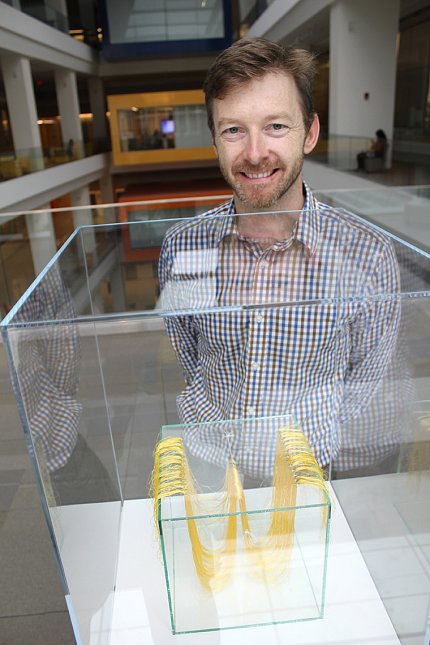Conway Joins NIH, Studies Color to Understand Vision

Neuroscientist and artist Dr. Bevil Conway has joined NEI’s Laboratory of Sensorimotor Research (LSR) as chief of the unit on sensation, cognition and action. Before joining NIH, he was associate professor of neuroscience at Wellesley College and a principal research scientist in the department of brain and cognitive sciences at Massachusetts Institute of Technology. His post at NIH is jointly affiliated with NINDS, NIMH and NIDA.
Conway investigates the neural basis for visual perception. He uses color perception as a model system for exploring how our brains process physical stimuli from our eyes. Much is already known about the encoding and transmission of signals from photoreceptors (the neurons in our retina that detect light) to the brain. Conway studies the neural mechanisms by which the brain decodes and processes signals from the retina.
“We take it for granted that we know what vision is because our brains do it so effectively,” Conway said. He uses color as a model for studying vision because “it connects a lot of the pieces of the puzzle. It’s a low-level attribute involving a measurable physical stimulus, yet color also taps into a host of high-level cognitive and emotional functioning. Anyone who has ever seen a young girl enthusiastically favor the color pink has witnessed how color is imbued with the social cues of gender identity,” he said.
“The LSR is one of the premier systems neuroscience research groups in the world,” said Dr. David Schneeweis, NEI deputy scientific director. “Dr. Conway’s innovative and groundbreaking efforts to understand how the brain processes information about color will fit perfectly. We are extremely excited to have him join the NEI IRP.”
Conway earned his undergraduate degree in biology at McGill University before studying neuroscience at Harvard, where he completed a master’s of medical science and earned his Ph.D. in neurobiology. After graduate school, he moved to Nepal to help launch the Kathmandu University Medical School, where he was director of education for physiology and pathophysiology of heart, lung and kidney. In 2003, he was elected a junior fellow in the Harvard Society of Fellows to pursue his combined interest in visual art and visual neuroscience. He also received a Humboldt fellowship to explore the functional organization of color circuits in posterior inferior temporal cortex before joining Wellesley College, and later also MIT.
When he is not in the lab, Conway is a professional painter and sculptor. Many of his works are displayed in private collections in Europe, Africa and North America and in the public collection of the Fogg Museum, the Boston Public Library and on semi-permanent exhibit at the Porter Neuroscience Research Center.
